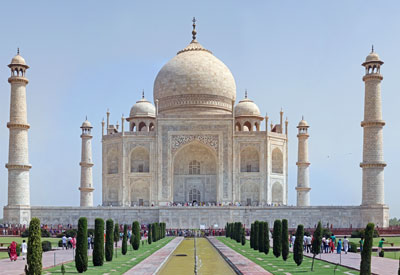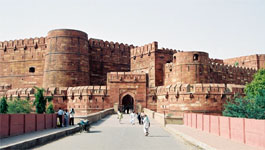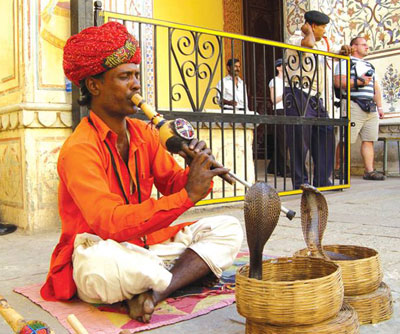|
|
|
|
Top India Destinations:
Mumbai (bombay) hotels Delhi hotels New Delhi hotels Bangalore hotels Jaipur hotels See more hotels in India
World Destinations:
 Guides » India » Taj Mahal India Guides » India » Taj Mahal IndiaTaj Mahal India
Just about everyone has heard of the Taj Mahal in India, a spectacular mausoleum of the Mughal Empress Mumtaz Mahal. From the swelling dome and square base people can always spot this symbol of India. The Taj Mahal is truly one of the world’s most amazing buildings, known around the globe for its magnificent architecture and tomb that is unlike none other.
Keep in mind that the Taj Mahal is a group of buildings that is comprised of a main gateway, beautiful garden, a mosque, prayer house, outer enclosures, enclosing walls, and of course, the tomb. It all began when in 1612, Arjumand Banu Begam, also called Mumtaz Mahal, was married to Shah Jehan, then called Prince Khurram who was the 5th Mughal emperor.  Although this was the emperor’s second marriage, the two were madly in love. In fact, the two of them were inseparable, taking many journeys and expeditions together. Mahal was the prince’s constant companion, his friend, counselor, and his inspiration to offer charity and benevolence to the weak and needy. Mahal also provided her husband with 14 children and then sadly, in 1630 she died while giving birth, just three years after his accession to the throne. Although this was the emperor’s second marriage, the two were madly in love. In fact, the two of them were inseparable, taking many journeys and expeditions together. Mahal was the prince’s constant companion, his friend, counselor, and his inspiration to offer charity and benevolence to the weak and needy. Mahal also provided her husband with 14 children and then sadly, in 1630 she died while giving birth, just three years after his accession to the throne.
Overwhelmed by grief, Jehan wanted to immortalize her memory, deciding to build a monument of eternal love. This everlasting love is what led Jehan to the design of the Taj Mahal. Because all of the people loved Mahal almost as much as her prince, they too worked hard to create this magnificent place. It took 21 long years of hard labor to complete the Taj Mahal and the efforts of more than 20,000 men and master artisans. Completed in 1648 on the banks of the river, today thousands and thousands of people come to share in the beauty of this complex. The name Taj Mahal translates to “Crown Palace”, which is an abbreviated version of Mahal’s name, which itself translates to “Exalted One of the Palace”. Main GatewayThe Main Gateway called Darwaza is what Jehan traveled from the fort to the tomb via boat. As he would arrive on the river’s side, he would then ascend to the terrace via the embankment. However, this particular approach was supposed to be just for the emperor and members of his party. Therefore, other people would enter through a large courtyard called a Jilokhana, as a means of entering the main south gateway.This courtyard was as far as travelers could go but also where the poor and needy would be given food and shelter. The gateway measures 150-feet wide and 100-feet tall. Made from red sandstone, the gateway is also heavily embellished. At the base is a massive door made from eight different types of metals and studded with knobs. Once inside, you will find numerous rooms with hallways that meander and then divide into confusion, with most people thinking this was intentional. GardensThe gardens of the Taj Mahal are called Bageecha, which is a magical place; a green carpet if you will that runs along the main gateway all the way to the base of the Taj. This Persian garden style was introduced by the first Mughal emperor, Baber. In addition to gardening, he also introduced them to fruit, flowers, leaves, birds, delicacy, and symmetry. For this particular garden, the landscape artists tried to translate heaven into earthly terms. These gardens at the Taj Mahal are irrigated with overflowing water from the canals, keeping it beautiful and green.MosqueThe mosque, called Masjid is located on the west side of the Taj Mahal. Facing toward Mecca, today it is a place for prayer. Now, the interesting thing about this is that just inside the enclosure along the western, bordered wall is a shaded structure that measures 19 feet by 6.5 feet. That very spot marks the location of where Mumtaz Mahal’s remains were laid to rest temporarily. From that spot, her remains were moved to their permanent home within the mausoleum.Inside the mosque is a beautifully polished marble piece that serves as a mirror so anyone entering can see the reflection of the mausoleum. The floor is also magnificent, made from a material that makes it look like red velvet. That very floor also features 539 prayer carpets, each marked out with black marble. You will also find intricate calligraphy, a ceiling painted in a unique design, a roof capable of supporting four octagonal towers along with the three domes, and then to the north and south and on the enclosure wall, two towers. Other features when visiting the Taj Mahal include the Rest House (Naqqar Khana), which is on the east side and a parallel structure made also from red sandstone and the actual tomb (Rauza), which is 900 feet from the Taj Mahal’s entrance and at the opposite end of the garden. When visiting India, this is the number one tourist attraction, which is easy to see why. Last Updated: 10/19/2006 3:14:00 PM Mode articles for India When visiting India, you will be met with clamor, diversity, and vastness. Although most people have a vision of what they expect India to be, remember that this country comes in many different forms. In other words,
When visiting India, you will be met with clamor, diversity, and vastness. Although most people have a vision of what they expect India to be, remember that this country comes in many different forms. In other words, ... continue >>  The famous Taj Mahal of India is located in a city called Agra, which at one time, was the capital of India. Located close to the Taj Mahal, the Agra Fort shares the same riverbank.
The famous Taj Mahal of India is located in a city called Agra, which at one time, was the capital of India. Located close to the Taj Mahal, the Agra Fort shares the same riverbank. ... continue >>  Nag Panchami, otherwise known as “Snake Day” is an event in India celebrated in a number of different ways. For example, in the city of Mumbai, cobras are venerated and fed sweet milk, most often by women.
Many
Nag Panchami, otherwise known as “Snake Day” is an event in India celebrated in a number of different ways. For example, in the city of Mumbai, cobras are venerated and fed sweet milk, most often by women.
Many ... continue >> |
|
| | |
|
©2025 HotelsRu.com About us Privacy Site map Visiting India |
|
 Look for deals on hotels?
Look for deals on hotels?